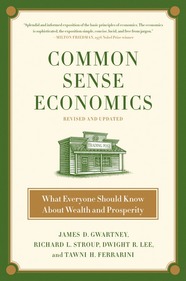Common Sense Economics: What Everyone Should Know About Wealth and Prosperity is a great little book that's loaded with practical knowledge about economics. I use the word “little” to describe this 227-page book because it is relatively small and light for a hardcover book, especially in comparison to most Economics course textbooks. It can be used as a textbook for students in high school or college for a semester-long course, or it can be read by anyone who wants to understand how economics work on both micro and macro levels.
The book has four main sections:
Part I: Twelve Key Elements of Economics
Part II: Seven Major Sources of Economic Progress
Part III: Ten Elements of Clear Thinking About Economic Progress and the Role of Government
Part IV: Twelve Key Elements of Practical Personal Finance
Each part begins with a list of the seven, ten, or twelve points, so you can grasp or review the main ideas for each section in just a minute or two. Each part has an introduction, then a fuller explanation of each point with specific examples from past or current events as well as practical applications.
While economics can be dry and difficult, this book is neither. For example, when discussing the government's role of “promoting economic progress by protecting the rights of individuals and supplying a few goods that are difficult to provide through markets (the first point of Part III), the authors write:
When government performs its protective function well, individuals can have confidence that they will not be cheated and that the wealth they create will not be taken from them—by either selfish intruders or the government itself through high taxes and excessive regulations or the ravages of inflation. This protection provides citizens with assurance that if they sow, they will be permitted to reap. When this is true, people will sow and reap abundantly, and economic progress will result (p. 97).
The authors explain this principle further, describing the “on-again, off again love affair” that Americans have with government. The section concludes by showing how the recent financial crisis was fueled by government intervention in the housing market that led to an expansion of credit for mortgages and the resultant boom and bust. They equate what happened with policies that led to the Great Depression (pp. 98-99).
While this book reflects free market and limited government preferences in regard to economic policy, it does so by using factual evidence and logic. It presents numerical information, but students need not brush up on higher math to understand it.
Part IV on practical finances should be required reading for everyone! It covers some of the expected topics such as budgeting, saving, compound interest, and investing in stocks and bonds, but it also addresses unusual topics rarely mentioned in other economics courses. For example, the first of the 12 key elements is “Discover your comparative advantage.” That section begins with a discussion of comparative advantage in regard to business but then shifts to the personal. It says, “Individuals will always be better off if they are really good at something that is highly valued by others.” It explains the value of being passionate about your work: “If you enjoy what you do and believe it is important, you will be happy to do more of it and work to do it better. Thus, competency and passion for an activity tend to go together…” and this is what really helps people to be successful (pp. 151-154).
In Part IV, some of the other key points advance entrepreneurship, explain why we should never finance anything that will be gone before it is paid for, and warn against investment schemes, especially those advertised by phone or email.
The authors have done a great job of making economics understandable for both teens and adults. Those who want to use this book as the basis of a course, will need to add your own assignments and assessments. Whether you use the book on its own or in conjunction with other resources, Common Sense Economics is truly a source of economic wisdom.









